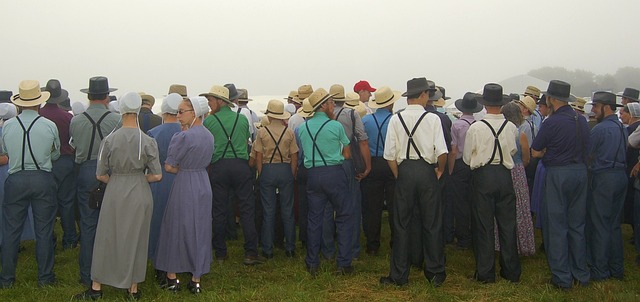The Amish, a traditionalist Christian group, adhere to a set of religious beliefs and practices that emphasize simplicity, humility, and separation from the modern world. As part of their commitment to modesty and humility, Amish women typically cover their hair, while men keep their hair cut short. This practice is rooted in their interpretation of biblical teachings and cultural traditions, which prioritize modesty, gender roles, and the preservation of their distinct identity within their community.
Table of Contents
The Significance of Hair in Amish Culture
Have you ever wondered why Amish women always wear their hair covered? It’s a common sight in Amish communities to see women wearing bonnets or scarves, but have you ever stopped to think about the significance behind this practice? In Amish culture, hair holds a deep symbolic meaning and is considered a sacred part of a woman’s identity.
For the Amish, hair is seen as a symbol of femininity and modesty. It is believed that a woman’s long hair should be reserved for her husband’s eyes only. By covering their hair, Amish women are showing respect for their husbands and their commitment to their marriage vows. It is a way of maintaining their modesty and upholding the traditional gender roles within their community.
But the significance of hair in Amish culture goes beyond modesty. Hair is also seen as a sign of submission to God’s will. The Bible teaches that a woman’s hair is her glory and should be kept long. By covering their hair, Amish women are demonstrating their obedience to God’s commandments and their willingness to submit to His authority.
In addition to its symbolic meaning, hair is also seen as a source of temptation and vanity. The Amish believe that excessive focus on physical appearance can distract from spiritual matters and lead to pride and arrogance. By covering their hair, Amish women are rejecting worldly beauty standards and embracing a simpler, more humble way of life.
The practice of covering hair is not limited to married women. Amish girls start wearing a covering as soon as they reach puberty. This marks their transition into adulthood and their readiness for marriage. It is a way of signaling to the community that they are now eligible for courtship and marriage.
The type of covering worn by Amish women varies depending on their age and marital status. Young girls typically wear a white prayer covering, while married women wear a variety of bonnets or scarves. The color and style of the covering can also vary between different Amish communities, reflecting their unique traditions and customs.
While the practice of covering hair is deeply ingrained in Amish culture, it is important to note that not all Amish groups adhere to this tradition. Some more progressive Amish communities may allow women to show their hair in certain situations, such as within the privacy of their own homes or among close family members. However, even in these cases, the underlying principles of modesty and humility still hold true.
In conclusion, the practice of covering hair in Amish culture holds great significance. It is a symbol of femininity, modesty, and submission to God’s will. By covering their hair, Amish women are demonstrating their commitment to their husbands, their faith, and their community. It is a powerful expression of their identity and values, and a reminder of the importance of humility and simplicity in their way of life.
Religious Beliefs and Modesty Practices of the Amish

Have you ever wondered why Amish women always wear their hair covered? It’s a common sight in Amish communities to see women wearing bonnets or headscarves, but have you ever stopped to think about the reasons behind this practice? In this article, we will explore the religious beliefs and modesty practices of the Amish that lead them to cover their hair.
The Amish are a religious group known for their simple and traditional way of life. They believe in living a life separate from the modern world, and their religious beliefs play a significant role in shaping their daily practices. Modesty is highly valued in the Amish community, and it is reflected in the way they dress and present themselves.
For Amish women, covering their hair is a symbol of modesty and submission to God. They believe that the Bible teaches women to cover their heads as a sign of respect and humility. This practice is based on a passage from the New Testament, specifically 1 Corinthians 11:6, which states, “For if a woman does not cover her head, she might as well have her hair cut off; but if it is a disgrace for a woman to have her hair cut off or her head shaved, then she should cover her head.”
By covering their hair, Amish women are following this biblical instruction and showing their commitment to their faith. It is a way for them to demonstrate their obedience to God and their willingness to adhere to the teachings of the Bible. It is also seen as a way to avoid drawing attention to oneself and to maintain a sense of humility.
In addition to religious reasons, the practice of covering their hair also serves as a way for Amish women to distinguish themselves from the outside world. The Amish believe in living a simple and separate life, and their appearance reflects this belief. By wearing bonnets or headscarves, Amish women are visibly different from women in mainstream society, who often wear their hair in various styles and colors.
The Amish value uniformity and conformity within their community, and the practice of covering their hair helps to maintain this sense of unity. It is a way for them to show solidarity with one another and to reinforce their shared values and beliefs. By adhering to this practice, Amish women are reminded of their commitment to their faith and their community.
It is important to note that not all Amish communities have the same rules regarding hair covering. Some Amish groups may require women to cover their hair at all times, while others may only require it during religious services or specific occasions. The specific rules and customs can vary depending on the particular Amish community and its interpretation of the Bible.
In conclusion, the practice of Amish women covering their hair is rooted in their religious beliefs and commitment to modesty. It is a way for them to demonstrate their obedience to God and their willingness to adhere to the teachings of the Bible. It also serves as a way for them to distinguish themselves from the outside world and maintain a sense of unity within their community. So, the next time you see an Amish woman wearing a bonnet or headscarf, you’ll have a better understanding of the reasons behind this practice.
Historical Origins of Hair Covering in Amish Tradition
Have you ever wondered why Amish women always wear their hair covered? It’s a common sight in Amish communities to see women wearing bonnets or scarves, but have you ever stopped to think about the reasons behind this tradition? In this article, we will explore the historical origins of hair covering in Amish tradition and shed some light on why they can’t show their hair.
To understand the Amish tradition of hair covering, we need to delve into their history. The Amish are a religious group that originated in Europe during the 16th century. They are known for their simple way of life, which includes dressing modestly and rejecting modern technology. The practice of hair covering is deeply rooted in their religious beliefs and has been passed down through generations.
In the early days of the Amish community, women were expected to cover their hair as a sign of humility and submission to God. This practice can be traced back to biblical teachings, specifically the writings of the apostle Paul in the New Testament. In his letters to the Corinthians, Paul states that women should cover their heads while praying or prophesying. The Amish interpret this as a commandment that applies to all aspects of their lives, not just during religious ceremonies.
The specific style of hair covering varies among different Amish communities. For example, in some communities, women wear white prayer caps, while in others, they wear bonnets or scarves. The choice of style often depends on the particular rules and customs of each community. Regardless of the style, the purpose remains the same – to maintain modesty and uphold their religious beliefs.
Hair covering also serves as a symbol of marital status within the Amish community. Unmarried women typically wear their hair in a braid, while married women cover their hair. This distinction helps to maintain order and respect within the community, as it clearly identifies a woman’s marital status. It also serves as a reminder of the commitment and responsibilities that come with marriage.
In addition to religious and cultural reasons, hair covering also has practical benefits for Amish women. The bonnets and scarves not only protect their hair from dust and dirt but also shield their faces from the sun. As the Amish community is primarily involved in farming and outdoor work, these practical considerations play a significant role in their choice to cover their hair.
While the tradition of hair covering may seem restrictive to some, it is an integral part of Amish culture and identity. It is a visible symbol of their faith and commitment to their religious beliefs. It is also a way for them to maintain their distinctiveness and separate themselves from the modern world.
So, the next time you see an Amish woman wearing a bonnet or scarf, remember that there is a rich history and deep meaning behind that simple piece of fabric. It represents centuries of tradition, religious devotion, and a way of life that is vastly different from our own. It is a reminder that even in our increasingly interconnected world, there are still communities that choose to live by their own set of values and beliefs.
Understanding the Symbolism Behind Amish Hair Coverings
Have you ever wondered why Amish women always cover their hair? It’s a common sight in Amish communities to see women wearing bonnets or scarves, but have you ever stopped to think about the reasons behind this practice? In this article, we will explore the symbolism behind Amish hair coverings and understand why they are an important part of Amish culture.
To truly understand the significance of Amish hair coverings, we need to delve into the core values and beliefs of the Amish community. The Amish are a religious group known for their simple and traditional way of life. They strive to live in accordance with their interpretation of biblical teachings, which emphasizes modesty, humility, and separation from the world.
For Amish women, covering their hair is a way to demonstrate their commitment to these values. Hair is considered a symbol of beauty and vanity in many cultures, and by covering their hair, Amish women are rejecting worldly notions of attractiveness. Instead, they focus on inner beauty and the virtues that truly matter to them.
The practice of covering hair also serves as a reminder of the biblical teachings on gender roles and submission. In the Bible, it is written that a woman’s long hair is her glory, but it should be covered as a sign of respect and submission to God and her husband. By covering their hair, Amish women are showing their obedience to these teachings and their willingness to submit to God’s will.
Another important aspect of Amish hair coverings is the sense of community and identity they provide. In Amish culture, conformity is highly valued, and individualism is discouraged. By wearing the same style of bonnet or scarf, Amish women are visually expressing their unity and solidarity with their community. It is a way of saying, “We are all in this together.”
Amish hair coverings also play a role in preserving the distinctiveness of the Amish community. In a world where fashion trends come and go, the Amish strive to maintain their unique identity and separate themselves from the outside world. By adhering to their traditional dress code, which includes hair coverings, the Amish are able to distinguish themselves and preserve their cultural heritage.
It’s important to note that not all Amish women cover their hair in the same way. The style and color of the bonnets or scarves can vary between different Amish affiliations or even individual families. These variations may seem subtle to an outsider, but they hold great significance within the Amish community. They serve as markers of identity and affiliation, allowing Amish women to express their individuality within the boundaries of their culture.
In conclusion, the practice of Amish women covering their hair is deeply rooted in their religious beliefs, cultural values, and sense of community. It is a symbol of modesty, humility, and submission to God’s will. By covering their hair, Amish women demonstrate their commitment to their faith and their desire to live a simple and separate life. So, the next time you see an Amish woman wearing a bonnet or scarf, remember the rich symbolism behind it and the values it represents.
Conclusion
The Amish do not show their hair as it is a cultural and religious practice rooted in their beliefs and traditions.
For licensing reasons, we must provide the following notice: This content was created in part with the help of an AI.


